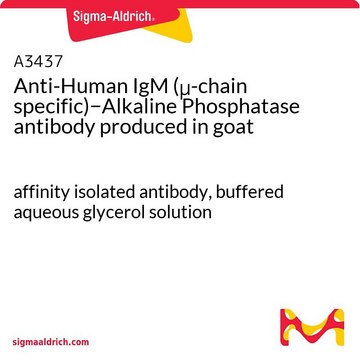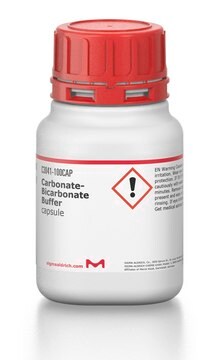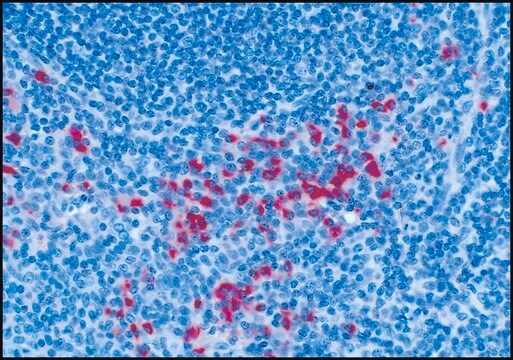A3275
Anti-Human IgM (μ-chain specific)−Alkaline Phosphatase antibody produced in goat
affinity isolated antibody, buffered aqueous glycerol solution
Synonym(s):
Goat Anti-Human IgM (μ-chain specific)−AP
Sign Into View Organizational & Contract Pricing
All Photos(1)
About This Item
Recommended Products
biological source
goat
Quality Level
conjugate
alkaline phosphatase conjugate
antibody form
affinity isolated antibody
antibody product type
secondary antibodies
clone
polyclonal
form
buffered aqueous glycerol solution
species reactivity
human
technique(s)
direct ELISA: 1:7,000-1:21,000
shipped in
wet ice
storage temp.
2-8°C
target post-translational modification
unmodified
Looking for similar products? Visit Product Comparison Guide
General description
IgM antibody is produced by B cells and has pentamer structure which helps the antibody in polyreactivity and can also remove apoptotic cells. Anti-human IgM (μ-chain specific) -alkaline phosphatase antibody can be used in solid phase ELISA for determination of anti-sp75 antibodies. Goat anti human IgM-alkaline phosphatase antibody reacts specifically with human IgM.
Immunogen
Human IgM.
Application
IgM is a glycoprotein with 5 n-linked glycosylation sites on the heavy chain. An ELISA assay was performed to identify glycosylated forms of IgM that bind to lectin. Alkaline phosphatase conjugated goat anti-human IgM was used as the secondary at 1:2000 and developed using p-nitrophenyl substrate (Sigma).
It may be used for immunoblotting.
Physical form
Solution in 0.05 M Tris, pH 8.0, containing 1% bovine serum albumin, 1 mM MgCl2, 15 mM sodium azide and 50% glycerol
Disclaimer
Unless otherwise stated in our catalog or other company documentation accompanying the product(s), our products are intended for research use only and are not to be used for any other purpose, which includes but is not limited to, unauthorized commercial uses, in vitro diagnostic uses, ex vivo or in vivo therapeutic uses or any type of consumption or application to humans or animals.
Not finding the right product?
Try our Product Selector Tool.
Storage Class Code
10 - Combustible liquids
WGK
WGK 3
Flash Point(F)
Not applicable
Flash Point(C)
Not applicable
Choose from one of the most recent versions:
Already Own This Product?
Find documentation for the products that you have recently purchased in the Document Library.
Equatorial Assembly of the Cell-Division Actomyosin Ring in the Absence of Cytokinetic Spatial Cues.
Tzer Chyn Lim et al.
Current biology : CB, 28(6), 955-962 (2018-03-06)
The position of the division site dictates the size and fate of daughter cells in many organisms. In animal cells, division-site placement involves overlapping mechanisms, including signaling from the central spindle microtubules, astral microtubules, and spindle poles and through polar
Immunoglobulin M Reactivity Towards the Immunologicdly Active Region sp75 of the Core Protein of Hepatitis C Virus (HCV) in Chronic HCV Infection.
U.B. Hellstrorn, S.P.E. Sylvan
Journal of Medical Virology, 39(4), 39325-39332 (1993)
Francesca Gori et al.
Journal of neuroimmunology, 233(1-2), 216-220 (2011-01-11)
Antibodies to MOG in serum have a dubious prognostic value in multiple sclerosis. The MOG recombinant protein conformational properties relevant to the antigenic activity are unknown. We employed a solid-phase ELISA based on a product (rMOG(ED)(His)(6)) expressed in E. coli
H A Cubie et al.
Journal of clinical pathology, 46(9), 840-845 (1993-09-01)
AIMS--To compare the sensitivity, specificity, and practicality of recombinant proteins in serological tests for the detection of human parvovirus B19 IgG and IgM. METHODS--Indirect enzyme linked immunosorbent assays using B19 structural proteins expressed in Escherichia coli were developed for the
Young Chan Kim et al.
Viruses, 11(5) (2019-05-06)
Chikungunya fever is a debilitating disease caused by Chikungunya virus (CHIKV) that can result in long-lasting arthralgias. The early diagnosis of CHIKV relies on PCR during the acute infection phase to allow differential diagnosis with other co-circulating arboviruses such as
Our team of scientists has experience in all areas of research including Life Science, Material Science, Chemical Synthesis, Chromatography, Analytical and many others.
Contact Technical Service







